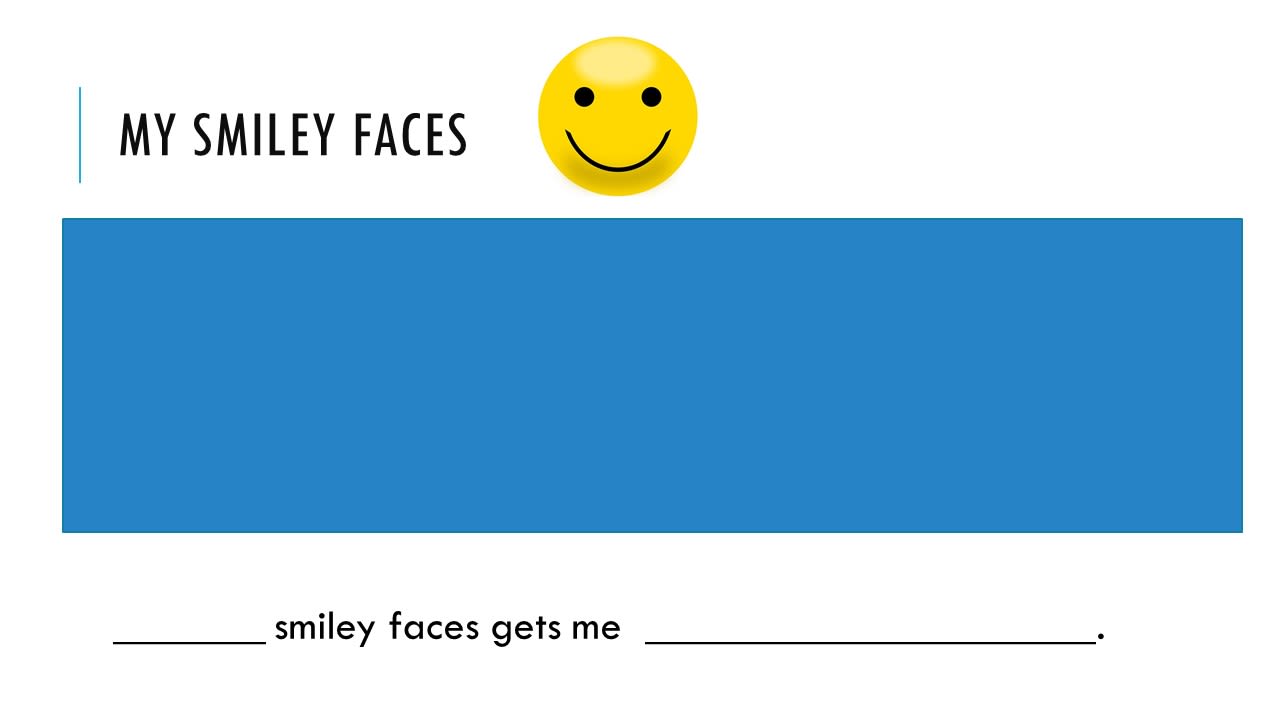Token Reward System/Visual Support: Smiley Faces

Description
Smiley Face Visual/Token Reward System for therapy use. ABA techniques.
Strategies and techniques
HOW TO USE:
*Laminate. Use a dry erase marker to draw smiley faces once task is completed.
You can decide ahead of time if student needs 2, 3, 5, 10 smiley faces to earn reward.
*Draw lines in blue box to represent number of smiley faces needed to earn reward/motivator.
*Each smiley can represent an amount of time spent on a task or a number of task items completed. Example: They earn a smiley face for 5 minutes of on-task behavior. OR They earn a smiley face for each class completed using an indoor voice. OR They earn a smiley face for each worksheet/work based task completed. OR They earn a smiley face for each attempt to answer Wh-questions.
*Once the student has completed the pre-decided number of trials/tasks, they earn time with their favorite motivator. Tip: provide the reward/motivator as soon as they have earned all smiley faces. Set a timer for the reward (so that it is not an indefinite period of time).
*Laminate. Use a dry erase marker to draw smiley faces once task is completed.
You can decide ahead of time if student needs 2, 3, 5, 10 smiley faces to earn reward.
*Draw lines in blue box to represent number of smiley faces needed to earn reward/motivator.
*Each smiley can represent an amount of time spent on a task or a number of task items completed. Example: They earn a smiley face for 5 minutes of on-task behavior. OR They earn a smiley face for each class completed using an indoor voice. OR They earn a smiley face for each worksheet/work based task completed. OR They earn a smiley face for each attempt to answer Wh-questions.
*Once the student has completed the pre-decided number of trials/tasks, they earn time with their favorite motivator. Tip: provide the reward/motivator as soon as they have earned all smiley faces. Set a timer for the reward (so that it is not an indefinite period of time).
License
Additional information
Resource details

Description
Smiley Face Visual/Token Reward System for therapy use. ABA techniques.
Strategies and techniques
HOW TO USE:
*Laminate. Use a dry erase marker to draw smiley faces once task is completed.
You can decide ahead of time if student needs 2, 3, 5, 10 smiley faces to earn reward.
*Draw lines in blue box to represent number of smiley faces needed to earn reward/motivator.
*Each smiley can represent an amount of time spent on a task or a number of task items completed. Example: They earn a smiley face for 5 minutes of on-task behavior. OR They earn a smiley face for each class completed using an indoor voice. OR They earn a smiley face for each worksheet/work based task completed. OR They earn a smiley face for each attempt to answer Wh-questions.
*Once the student has completed the pre-decided number of trials/tasks, they earn time with their favorite motivator. Tip: provide the reward/motivator as soon as they have earned all smiley faces. Set a timer for the reward (so that it is not an indefinite period of time).
*Laminate. Use a dry erase marker to draw smiley faces once task is completed.
You can decide ahead of time if student needs 2, 3, 5, 10 smiley faces to earn reward.
*Draw lines in blue box to represent number of smiley faces needed to earn reward/motivator.
*Each smiley can represent an amount of time spent on a task or a number of task items completed. Example: They earn a smiley face for 5 minutes of on-task behavior. OR They earn a smiley face for each class completed using an indoor voice. OR They earn a smiley face for each worksheet/work based task completed. OR They earn a smiley face for each attempt to answer Wh-questions.
*Once the student has completed the pre-decided number of trials/tasks, they earn time with their favorite motivator. Tip: provide the reward/motivator as soon as they have earned all smiley faces. Set a timer for the reward (so that it is not an indefinite period of time).
License
Focus area
Evidence based practice citations
-
How Attention Affects Speech and Language Development
Author(s): Kids Creek Therapy -
Executive Functioning and Social Pragmatic Communication Skills: Exploring the Threads In Our Social Fabric
Author(s): Winner, M. & Crooke, P.
Grade levels
Grades PK - 12
Themes
None
Weekly Themes
None
Daily Themes
None
Blends
None
Phonemes
None
Resource slides
Create a free Ambiki account to preview the slides of this PDF resource.
